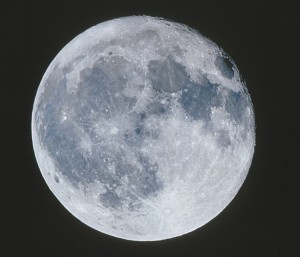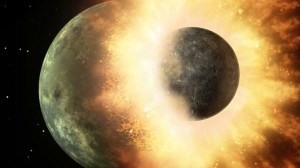How Many Moonlets to a Moon?
Friday, February 3rd, 2017February 3, 2017
One of the greatest questions in the formation of the solar system is in our own planetary back yard: how was the moon made? The current hypothesis (proposed explanation)—that the moon formed from chunks of Earth unloosed in a massive collision—has held sway among planetary scientists for over 30 years. But as more is learned about the moon, scientists are exploring other possibilities, and three scientists in particular—Raluca Rufu and Oded Aharonson of the Weizmann Institute of Science, Israel, and Hagai B. Perets of the Technion Israel Institute of Technology—are offering a different explanation. They published their new theory last month in the journal Nature Geoscience.

A new theory suggests that the moon may have formed from debris unloosed by many small impacts on Earth rather than one big one. Credit: Lunar and Planetary Institute
Since the early days of astronomy, people have speculated on how the moon was formed. In the 1800’s, astronomers used to think that the moon split from Earth—but in a very peculiar way. The accepted hypothesis of that era said that in the distant past Earth spun so rapidly that a portion of it tore away, forming the moon and leaving behind a basin that became the Pacific Ocean. Scientists now know that plate tectonics formed the Pacific Ocean over hundreds of millions of years, and that Earth lacks the rotational speed to create such a spectacular split. In recent years, engineers have developed powerful computers that allow geologists to take new and closer looks at rocks returned from the Apollo moon landings from 1969 to 1972.

This artist rendering depicts the “Big Whack” hypothesis of Earth colliding with a planetary body. The resulting dust and debris from Earth would then have created the moon. (Credit: NASA/JPL-Caltech)
Since the 1980’s, one hypothesis has stood up best to scrutiny: that the moon formed as a result of a massive collision known as the Giant Impact or the “Big Whack.” According to this idea, a Mars-sized object collided with Earth about 4.6 billion years ago. As a result of the impact, a huge cloud of vaporized rock shot off Earth’s surface and went into orbit around Earth. The cloud cooled and condensed into a ring of small, solid bodies, which then gathered together, forming the moon.
If the Big Whack is favored, why are Rufu, Aharonson, and Perets exploring alternative ideas? The Big Whack explains many of the orbital and rotational characteristics of both Earth and the moon, but the hypothesis must be tweaked to an uncomfortable degree to account for the remarkable similarity of Earth rocks to moon rocks. The giant impactor would have had to have struck Earth in an extremely precise way to produce a moon with the makeup shown by returned lunar samples.
Therefore, the Israeli team started from scratch. They reasoned that because impacts were common in the early solar system, Earth should have been hit with objects large enough to create moons many times, not just once. They ran hundreds of computer simulations and found that a series of smaller impacts over the course of millions of years could explain the compositional similarity of Earth and its moon. A smaller body (more the size of the dwarf planet Ceres) would slam into Earth, forming a disk of debris that would eventually come together to form a moonlet, or mini-moon. Later, another body would collide with Earth, creating a new debris disk and another moonlet. Eventually, these moonlets would merge with one another. To reach the size of the current moon, a number of such collisions and moonlet creations and mergings (their guess was roughly 20) would be needed.
The new study is intriguing, but it does not disqualify the Giant Impact Hypothesis just yet. Rufu and her colleagues admit that much more research needs to be done to confirm their findings. For instance, the group did not determine if some of the moonlets could have been sucked back into Earth or flung out into the solar system. This would increase the number of impacts needed to make our moon, making this explanation less likely than a precise Giant Impact.





